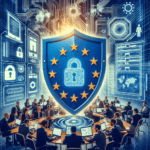
—

—
### The Importance of NIS2 in European Cybersecurity: A New Era for Data Protection
In recent years, the increasing sophistication of cyberattacks has compelled governments and organizations to reevaluate their security strategies. With the emergence of increasingly complex threats, cybersecurity has become a global priority, prompting the European Union to introduce the NIS2 directive. This regulation represents a crucial step toward adequate preparedness and response to cyberattacks, focusing on stronger cooperation among member states.
### An Expanded Scope of Action
NIS2 does not limit itself to protecting traditional sectors considered “high-criticality,” such as energy, transport, finance, and health. Its scope also extends to other essential service providers, covering, for example, telecommunications, digital services, and waste management. This broadening of the regulation acknowledges that threats can arise from various sources and that all sectors can be vulnerable to cyberattacks.
### Risk Management and Reporting Obligations
One of the main innovations introduced by NIS2 is the implementation of managerial and operational measures to address cybersecurity-related risks. Organizations are now required to adopt proactive approaches to risk management, continuously assessing vulnerabilities and implementing mitigation practices. These practices not only improve the security of data and information but also help foster a culture of security within companies.
Additionally, the directive establishes stringent reporting obligations for security incidents that may significantly impact operations. This means that in the event of a breach or attack, companies have a duty to notify the competent authorities within a predetermined timeframe, thus contributing to a timely and coordinated response at the European level.
### Cybersecurity: An Ever-Present Type of Risk
The landscape of cybersecurity is constantly evolving, and cyber threats are becoming increasingly sophisticated and frequent. Among the various types of risks, those related to ransomware, phishing, and DDoS attacks are among the most well-known and harmful. Not only do attack technologies continue to improve, but defense methods must also evolve accordingly.
In discussing these issues, experts have emphasized the importance of not only implementing technical protection measures but also developing a general awareness of cyber risks. Training and raising awareness among employees are crucial, as often the most successful attacks are based on human errors.
### DORA and ISO27001: A Necessary Comparison
Within the realm of cybersecurity, it is interesting to note the comparison between NIS2 and other regulations and standards, such as DORA (Digital Operational Resilience Act) and ISO 27001. Both of these standards provide a useful regulatory and operational framework for addressing digital risks.
DORA, for instance, specifically focuses on the digital operational resilience of financial institutions, while ISO 27001 offers an information security management model applicable to any organization, regardless of the sector. Each regulation has its strengths and peculiarities, but the integration of these different standards is essential for comprehensive and coherent protection.
### Threat Mitigation: Effective Strategies
Another crucial aspect discussed during the meetings on this topic concerns threat mitigation. Companies must develop response strategies that not only address incidents that have already occurred but also anticipate potential attacks. This includes, among other things, the implementation of advanced technologies, such as artificial intelligence systems for threat analysis and automation of incident responses.
Furthermore, adopting a holistic approach is vital.


